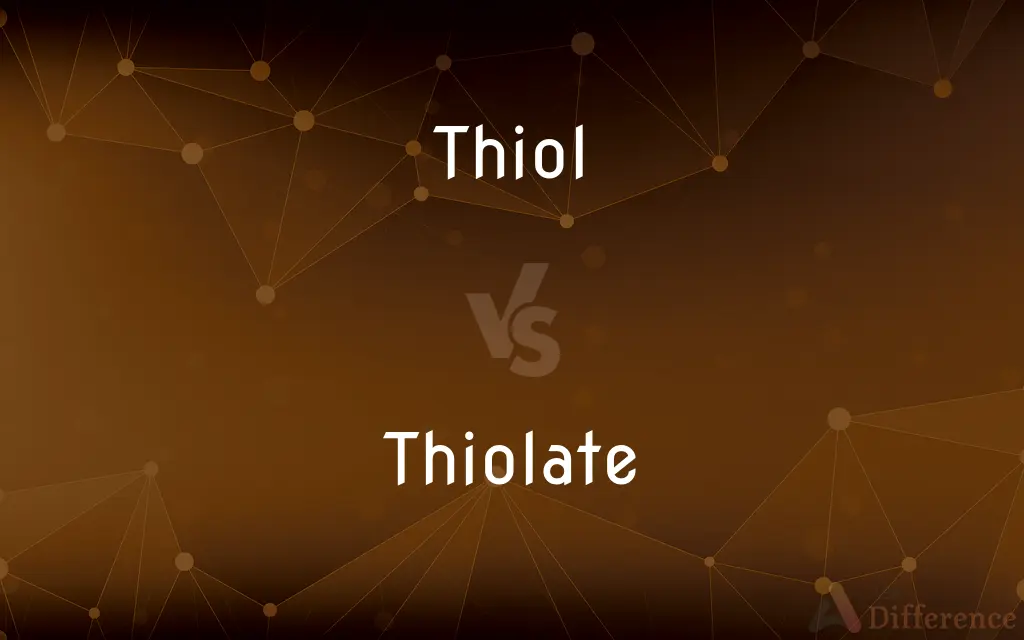Thiol vs. Thiolate — What's the Difference?
Edited by Tayyaba Rehman — By Fiza Rafique — Updated on April 4, 2024
Thiol refers to organic compounds containing a sulfhydryl (-SH) group, while thiolate is the conjugate base of a thiol, resulting from deprotonation of the sulfhydryl group.

Difference Between Thiol and Thiolate
Table of Contents
ADVERTISEMENT
Key Differences
Thiols are a class of organic compounds characterized by the presence of a sulfhydryl group (-SH), similar to alcohols but with sulfur replacing oxygen. On the other hand, thiolates are the negatively charged conjugate bases formed when thiols lose a hydrogen atom from their sulfhydryl group, resulting in an anion (-S^-).
The chemical reactivity of thiols is defined by the -SH group, which can participate in various reactions including oxidation and nucleophilic substitution. Thiolates, due to their negative charge, are more reactive and serve as strong nucleophiles in chemical reactions.
In terms of acidity, thiols are weak acids with pKa values generally around 10, making them more acidic than alcohols. Thiolates are formed in environments where the pH is higher than the pKa of the thiol, indicating a basic condition that facilitates deprotonation.
Thiols are found in many biological molecules, where they play critical roles in enzyme activity and the formation of disulfide bonds in proteins. Thiolates, being more reactive, are often intermediates in enzymatic reactions and play pivotal roles in catalysis and electron transfer processes.
The smell of thiols is notably strong and often unpleasant, contributing to the odors of garlic, onions, and skunk spray. Thiolates, while chemically related, are usually discussed in terms of their reactivity rather than their sensory properties.
ADVERTISEMENT
Comparison Chart
Chemical Structure
Contains a sulfhydryl group (-SH)
Sulfhydryl group is deprotonated, forming -S^-
Reactivity
Reactive, but less so than thiolates
More reactive due to negative charge
Acidity
Weak acids, pKa ~10
Conjugate base of thiols, formed at higher pH
Role in Biology
Important in proteins and enzymes
Intermediate in enzymatic reactions
Odor
Often strong and unpleasant
Discussed in terms of reactivity, not sensory properties
Compare with Definitions
Thiol
Organic compounds with a sulfhydryl group.
Glutathione, a thiol, is crucial for cellular defense against oxidative stress.
Thiolate
Strong nucleophiles in chemistry.
Thiolates can attack electrophilic carbon centers in organic synthesis.
Thiol
Characterized by strong odors.
The distinct smell of garlic is due to thiols.
Thiolate
Negatively charged sulfur species.
Thiolate ions are produced by deprotonating thiols.
Thiol
Sulfur analogs of alcohols.
Methanethiol is a simple thiol with a strong odor.
Thiolate
Not characterized by odor.
Thiolates' chemical interest lies in their reactivity, not their smell.
Thiol
Weak acids in chemical nature.
The pKa of ethanethiol shows it's a weak acid.
Thiolate
Formed in basic conditions.
Sodium thiolate is formed when sodium hydroxide reacts with thiols.
Thiol
Found in biological systems.
Thiols are important in forming disulfide bonds in proteins.
Thiolate
Active in enzyme catalysis.
Thiolate ions are crucial for the activity of many enzymes.
Thiol
A thiol () or thiol derivative is any organosulfur compound of the form R−SH, where R represents an alkyl or other organic substituent. The –SH functional group itself is referred to as either a thiol group or a sulfhydryl group, or a sulfanyl group.
Thiolate
(chemistry) any derivative of a thiol in which a metal atom replaces the hydrogen attached to sulfur RSH => RS-M+
Thiol
An organic compound containing the group —SH, i.e. a sulphur-containing analogue of an alcohol.
Thiol
A sulfur-containing organic compound with the general formula RSH where R is any hydrocarbon group. Also called mercaptan.
Thiol
(organic chemistry) A univalent organic radical (-SH) containing a sulphur and a hydrogen atom; a compound containing such a radical.
Common Curiosities
Why are thiols more acidic than alcohols?
Thiols are more acidic due to the less electronegative nature of sulfur compared to oxygen, facilitating easier proton release.
How are thiolates used in chemical reactions?
Thiolates, being strong nucleophiles, are used as intermediates in various chemical and enzymatic reactions.
What defines a thiol?
A thiol is an organic compound containing a sulfhydryl (-SH) group.
How is a thiolate formed from a thiol?
A thiolate is formed by the deprotonation of the sulfhydryl group in a thiol, resulting in a negative charge.
Can thiolates exist under normal conditions?
Thiolates can exist under basic conditions, where the pH is higher than the pKa of the corresponding thiol.
What is the significance of thiolates in enzymatic catalysis?
Thiolates often act as active sites in enzymes, facilitating catalysis through their reactivity.
Why do thiols have strong odors?
The strong odors associated with thiols are due to volatile compounds that easily interact with olfactory receptors.
How do thiolates contribute to organic synthesis?
Thiolates contribute as nucleophiles, participating in the synthesis of complex organic molecules.
Can thiols and thiolates be interconverted?
Yes, thiols and thiolates can be interconverted through protonation and deprotonation reactions.
How does the chemical structure of thiols affect their properties?
The sulfhydryl group in thiols is key to their reactivity, acidity, and biological function.
Are all thiols found in nature?
Many thiols are found in nature, playing diverse roles in biological and environmental systems.
What role do thiols play in biology?
Thiols are crucial in biological systems for enzyme activity and the formation of disulfide bonds in proteins.
How is the study of thiols and thiolates relevant to medicine?
Understanding thiols and thiolates is essential for developing drugs and treatments, especially in targeting diseases related to oxidative stress and enzyme function.
What is the environmental impact of thiols?
Thiols can contribute to odors and toxicity in the environment but are also part of natural biological processes.
What is a common use of thiols in industry?
Thiols are used in petroleum refining, pharmaceuticals, and the production of chemicals and materials.
Share Your Discovery

Previous Comparison
Monothetic vs. Polythetic
Next Comparison
Mouse vs. KeyboardAuthor Spotlight
Written by
Fiza RafiqueFiza Rafique is a skilled content writer at AskDifference.com, where she meticulously refines and enhances written pieces. Drawing from her vast editorial expertise, Fiza ensures clarity, accuracy, and precision in every article. Passionate about language, she continually seeks to elevate the quality of content for readers worldwide.
Edited by
Tayyaba RehmanTayyaba Rehman is a distinguished writer, currently serving as a primary contributor to askdifference.com. As a researcher in semantics and etymology, Tayyaba's passion for the complexity of languages and their distinctions has found a perfect home on the platform. Tayyaba delves into the intricacies of language, distinguishing between commonly confused words and phrases, thereby providing clarity for readers worldwide.














































